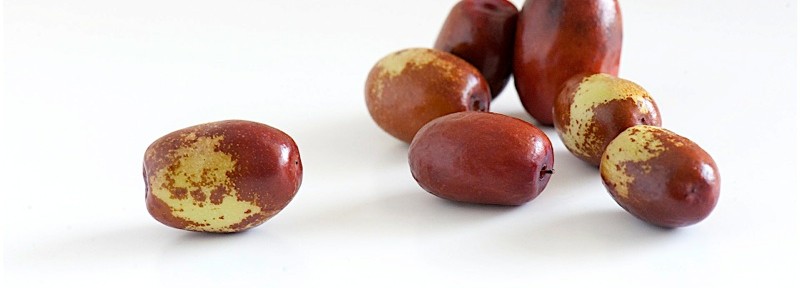 Jujube is one of the so called “alternative fruits”, as opposed to the classics of the fruit world: apples, pears, peaches, etc. Known as Ziziphus jujuba in scientific nomenclature, the fruit has many other names associated with it. Names like Giuggiolo, Christ’s Thorn, Jujube or Chinese Date. Although relatively unknown in the American South, it has (since its official introduction by the United States Department of Agriculture) always had a presence here among gardeners who love the unusual. One of those good souls is Charles Meador who gave me a jujube tree several years ago. But somehow, in planting my new garden landscape, the jujube got lost in the shuffle and forgotten. That was until Mr. Meador recently brought me by a sack full of jujube fruit. My interest again was aroused. As its many common names suggest, the fruit is grown from the northern Mediterranean where it is known to the Italians as “Giuggiolo”. In the Levant it is grown as Christ’s Thorn where it is associated with “the crown of thorns” of John 19:5 and the exclamations of Christians… ”who do we pray to?…we pray to the King who was crowned with thorns!”. Further east, it is grown as Chinese Date. Clearly, this wide spread use and extensive cultivation is the reason there are over 400 named cultivars. The plant is somewhat rare here but not in the old world. All kinds of folklore travels with the jujube. In the Himalayas the sweet smelling jujube is thought to make teenagers fall in love; and, as a result, young men take stems of the sweet-smelling jujube flowers with them to attract women. (Men are such fools… it is well known and common knowledge that wealth is the greatest of aphrodisiacs.) To the Moslem of the Middle East, sitting under a Jujube tree is considered lucky, since the Prophet saw such a tree in Paradise. The more popular a plant, the more stories there are. We here in East Texas can grow the jujube without much difficulty. The tree will grow in a wide range of temperatures and rainfall, though in very hot summers irrigation is required for prolific fruiting. It will tolerate fairly cold winters, ( Mr. Meador’s tree bore well in spite of this last year’s cold weather.) The plant has no major disease nor insect problems. It is an attractive ornamental, growing to 25’ and exhibiting interesting trunk and branching habits. And what’s more, it bears sweet fruit that somewhat resembles crisp apples. The Jujube should be more well known!
Jujube is one of the so called “alternative fruits”, as opposed to the classics of the fruit world: apples, pears, peaches, etc. Known as Ziziphus jujuba in scientific nomenclature, the fruit has many other names associated with it. Names like Giuggiolo, Christ’s Thorn, Jujube or Chinese Date. Although relatively unknown in the American South, it has (since its official introduction by the United States Department of Agriculture) always had a presence here among gardeners who love the unusual. One of those good souls is Charles Meador who gave me a jujube tree several years ago. But somehow, in planting my new garden landscape, the jujube got lost in the shuffle and forgotten. That was until Mr. Meador recently brought me by a sack full of jujube fruit. My interest again was aroused. As its many common names suggest, the fruit is grown from the northern Mediterranean where it is known to the Italians as “Giuggiolo”. In the Levant it is grown as Christ’s Thorn where it is associated with “the crown of thorns” of John 19:5 and the exclamations of Christians… ”who do we pray to?…we pray to the King who was crowned with thorns!”. Further east, it is grown as Chinese Date. Clearly, this wide spread use and extensive cultivation is the reason there are over 400 named cultivars. The plant is somewhat rare here but not in the old world. All kinds of folklore travels with the jujube. In the Himalayas the sweet smelling jujube is thought to make teenagers fall in love; and, as a result, young men take stems of the sweet-smelling jujube flowers with them to attract women. (Men are such fools… it is well known and common knowledge that wealth is the greatest of aphrodisiacs.) To the Moslem of the Middle East, sitting under a Jujube tree is considered lucky, since the Prophet saw such a tree in Paradise. The more popular a plant, the more stories there are. We here in East Texas can grow the jujube without much difficulty. The tree will grow in a wide range of temperatures and rainfall, though in very hot summers irrigation is required for prolific fruiting. It will tolerate fairly cold winters, ( Mr. Meador’s tree bore well in spite of this last year’s cold weather.) The plant has no major disease nor insect problems. It is an attractive ornamental, growing to 25’ and exhibiting interesting trunk and branching habits. And what’s more, it bears sweet fruit that somewhat resembles crisp apples. The Jujube should be more well known!
Giuggiolo, Christ’s Thorn, Jujube or Chinese Date

2 responses to “Giuggiolo, Christ’s Thorn, Jujube or Chinese Date”
Good to find your very informative article. I tasted this fruit in the market at Padua, Italy in October some years ago. Not having written it down, I had forgotten its name till I googled a kind of description, in Italian, today. Your article came up and I recognised it instantly. Haven’t found any in England so far. Good excuse to to Italy again.
Best regards
Elisabeth de Veer
Thanks for your kind words!